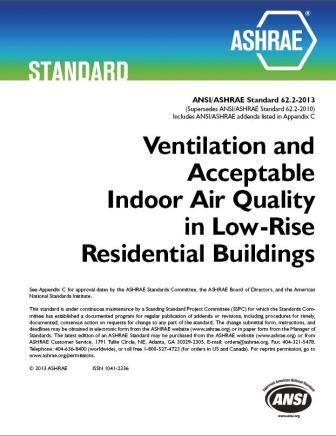What this tool does

The ASHRAE 62.2-2013 RED Calc tool handles all the requirements of the Standard, including new and existing buildings, the alternative compliance path, and infiltration credit. We have added useful features, including the advanced blower door inputs option, the fan-run time option for intermittent operation of dwelling-unit ventilation, and the dwelling-unit leakage rate solver.
This tool complies with all of the requirements of the ASHRAE 62.2-2013 Standard, so you can use it with confidence.
Calculated values
- Effective annual average infiltration rate.
- Dwelling-unit Total required ventilation rate, Qtot.
- Alternative compliance supplement.
- Infiltration credit, Qinf.
- Dwelling-Unit Required mechanical ventilation rate, Qfan.
- Fan run-time per hour.
- Corresponding measured leakage @ 50Pa for a chosen dwelling-unit ventilation rate.
Tips
- Clicking the label for any input or result will cause a popup help box to appear. This help box includes the allowed and normal values (for inputs).
- The 2013 version of the ASHRAE 62.2 Standard includes multifamily buildings of three stories or fewer above grade. Taller buildings are addressed by ASHRAE 62.1-2013.
- Weather data is included for the United States and Canada. The weather data for the 2013 tool includes 1100 locations in North America.
- As an aid in finding the closest weather station location, use the Weather Station Data (TMY) RED Calc Free tool. Select the “Show map” checkbox to select the closest weather station on the Google map.
- You may choose to use the Advanced Blower Door Inputs to adjust your results for temperature, altitude, and pressure exponent.
- You may choose to use the Local Ventilation Alternative Compliance feature for existing dwellings. This feature includes one kitchen and from one to five bathrooms. This option may not be used for new buildings, based on the requirements of the 62.2-2013 Standard.
- For new construction, the infiltration credit is limited to 2/3 of the Total required ventilation rate, Qtot. The RED Calc Free 62.2-2013 Ventilation tool automatically calculates this limit for you. The existing building infiltration credit is not limited by this 2/3 rule.
- The Dwelling-Unit Ventilation Run-Time Solver allows you to determine run-time per hour if you wish to operate the dwelling-unit fan intermittently.
- The Dwelling-Unit Leakage Rate Solver allows you to determine the measured leakage rate at 50 pascals that corresponds to a chosen dwelling-unit mechanical ventilation rate.
- The ASHRAE 62.2 Standard is written as a minimum standard; you may exceed the minimum requirements of the Standard.
Background
Although the first version of the ASHRAE Standard 62.2, Ventilation and Acceptable Indoor Air Quality in Low-Rise Residential Buildings, was published in 2003; the 2010 version was the first to gain national attention.
The Wisconsin low-income weatherization program was the first organization to adopt the residential ventilation/IAQ standard, in late 2004. The adoption of the ventilation/IAQ standard gained momentum in 2011 when the Department of Energy required the use of ASHRAE 62.2-2010 in the low-income weatherization program by the end of the 2012 program year. In 2013 the Building Performance Institute (BPI) adopted the 2013 version of the standard.
Best Practices
- In order to use the infiltration credit for a new dwelling, you must conduct a blower door test. The appropriate sequence to use for a new dwelling is as follows: First, you must estimate what you think the blower door test value will be when the dwelling is completed. Second, install a dwelling-unit fan with a capacity that exceeds your estimate for the final airflow rate. Third, conduct the blower door test when the dwelling is finished. Finally, adjust the dwelling-unit ventilation fan airflow rate with a variable-speed control to satisfy the actual dwelling-unit airflow rate, Qfan. Or, if you are using intermittent operation of the dwelling-unit ventilation fan, adjust the run time of the fan to correspond with the “Required mechanical ventilation rate, Qfan.
- Regarding the infiltration credit and the required blower door testing, ASHRAE 62.2-2013 Standard states: “Effective Annual Average Infiltration Rate” shall be calculated using the normalized leakage calculated from measurements of envelope leakage using either ASTM E779 or CGSB 149.10. The authority having jurisdiction may approve other means of calculating effective leakage area (ELA), such as the RESNET Mortgage Industry National Home Energy Systems Standard.” (ASHRAE 62.2-2013, Section 4.1.2). Both ASTM E779 and CGSB 149.10 require multi-point blower door tests. In other words, when using the infiltration credit, you are not in compliance with the Standard unless you do a multi-point blower door test, unless your “authority having jurisdiction” allows you to use a single-point test. So, keep in mind that unless you have approval, a single-point blower door text is not in compliance with the Standard.
- The ASHRAE 62.2-2013 Standard allows the use of the alternative compliance path (Appendix A of the Standard) for existing dwellings. This path allows compensation for deficits in local ventilation (kitchens and bathrooms) by increasing the flow rate of dwelling-unit ventilation. Generally, the use of this alternative path saves installation time and money, but it might result in lower indoor air quality. Whenever possible, avoid the use of the alternative compliance path and install separate local and dwelling-unit ventilation fans.